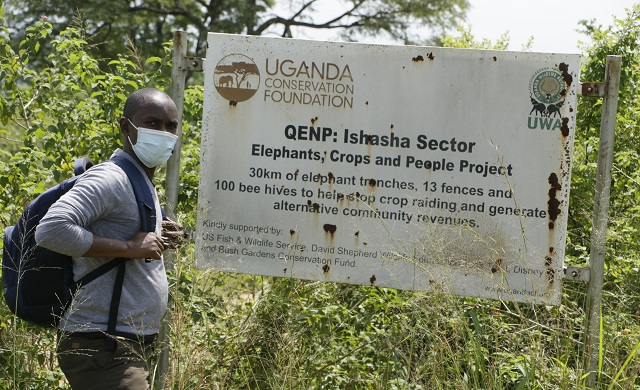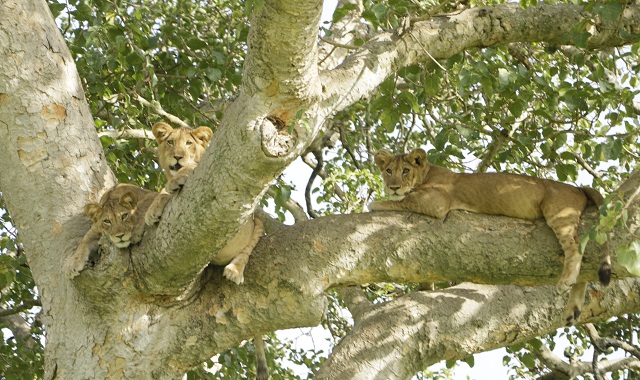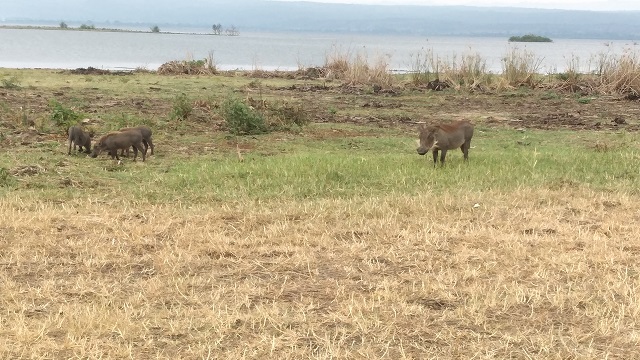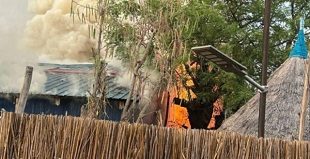
Kampala, Uganda | RONALD MUSOKE | As Uganda joined the rest of the world to commemorate the World Wildlife Day (March 3), Sam Mwanda, the executive director of the Uganda Wildlife Authority (UWA) paid tribute to the people who live near the country’s protected areas referring to them as the agency’s “biggest partners.”
Mwanda was speaking at a public lecture in Kampala on March 1 which was organized by Nature Uganda and the Ministry of Tourism, Wildlife and Antiquities under the theme: “State of Wildlife in Uganda: the role of partnership in wildlife conservation.” The theme was borrowed from the international theme: “Partnerships for Wildlife Conservation: Honouring the People Who are Making a Difference.”
Although he mentioned dozens of partners that have worked with UWA over the last 30 years in resuscitating the country’s wildlife resources, Mwanda reiterated the importance of the frontline communities whom he said were UWA’s most important partners in the conservation of the country’s rare wildlife species. “If we failed to work with the neighbouring communities, we would have failed to manage wildlife.”
Mwanda noted how, thanks to the various partnerships, UWA has over the last three decades grown back populations of key wildlife species including; elephants, giraffes, the Mountain Gorillas, the Uganda Kob and even vultures.
“There was a time when our wildlife was almost gone; there was a time when looking for just 2,000 elephants was hard. That number has since grown to about 8000. There was a time when Mountain Gorillas were just about 250 in the country; that number is now over 450.”
“There was a time when the giraffe population was may be 400-500, now they are over 2,000. The Uganda Kob was just about 40,000, now we are counting about 170,000.”
Mwanda, however, noted that the success needs to be put into perspective since there are some wildlife species that the country “needs to work on.” He mentioned lions among the few species that have not grown over the same period.
“The lions have been stagnant for a while,” he said, “We are currently doing a count but we fear they might be going down. The trends show that if you go to a park, for you to be able to see a lion is not as easy as it used to be.”
Dr. Gladys Kalema-Zikusoka, the founder and Chief Executive Officer of Conservation Through Public Health, a local non-profit that promotes harmonious co-existence between wildlife and people who live on the fringes of protected areas also spoke during the public lecture.
She too paid tribute to the many partners who have worked tirelessly to nurture and protect the Mountain Gorilla population in the southwest of the country. Dr. Zikusoka participated in the first ever Mountain Gorilla census in 1997 where the team counted about 300 Mountain Gorillas.
By 2018, she said, the number had climbed to 459. It was the same year that the International Union for the Conservation of Nature (IUCN) removed the Mountain Gorilla from the Critically Endangered Species List and placed them on “Endangered Species List” thanks to their steady recovery.
She said the Mountain Gorilla is the only sub-species whose numbers have gone up and it’s the only sub-species that has raked in tourism revenues in millions of dollars for both Uganda and neighbouring Rwanda.
Dr. Zikusoka attributed the recovery of the Mountain gorilla population to more law enforcement; better veterinary care, more monitoring, research and community engagement.
The Uganda Wildlife Authority, the local government, the NGOs and tour operators who bring in tourists to see the gorillas have all played a great role in Mountain Gorilla conservation, she said.
Tom Butime, the Minister of Tourism, Wildlife and Antiquities also paid tribute to the various partners who have over the years collaborated with the Ugandan government to conserve the country’s wildlife.

In his speech read at the public lecture by undersecretary Samuel Kironde Kakura, the tourism minister noted that the government’s partnership with the private sector in wildlife conservation have helped unlock a lot of investment opportunities especially in remote areas that are adjacent to Uganda’s protected areas.
The unlocking of investments, he said, has resulted into development of those areas while improving the welfare of communities we have discovered that disposable incomes of these communities have improved.
“The multiplier effect of such investments is quite visible when you visit communities living adjacent to our protected areas. Schools have been built; roads have been constructed and health facilities among others have also been developed.” “These are the benefits of the partnerships between government, the private sector and all those other partners involved in conservation.”
Challenges remain
Yet, as the wildlife numbers keep swelling, Mwanda said UWA’s biggest challenge has to do with the fact that both Uganda’s human and wildlife populations are expanding at the same time. He said wildlife populations are expanding mainly in Uganda’s protected areas (game parks, reserves and sanctuaries).
“But (remember) we have a wide habitat outside that belongs to me, you, a local clan or another individual but they are degrading these habitats.”
He gave the example of a stretch along the Masaka-Mbarara highway, from Lyantonde up to Mbarara in western Uganda. Mwanda said this whole stretch used to be wild.
“People living there used to keep cattle and other livestock but it was wild. So, travelers had a chance to see zebras, buffaloes, Impalas along the road. Now, if you drive ten times along this stretch, you will be lucky to count one zebra.”
“Why is that? The landowners have moved away from just keeping cattle to growing bananas; those who were comfortable looking after the Ankole cattle are now keeping cross-breed cattle which require different management. There are also factories in there.”
“Because of all this, the habitat for wildlife is being lost, the wild plants are being cleared. And it is not only this section of the country. Every part of the country, everybody is converting their land into some agricultural activity and that is a big challenge that we are grappling with.”
Dr. Zikusoka agreed with the UWA boss.
She noted that the growing number of Mountain Gorillas and other wildlife implies that there is need for more space. She noted that the habituation of gorillas has meant that these apes have lost the fear for people so there is a lot of interactions with people.
“They easily move into people’s gardens and are eating people’s bananas but they are also picking up diseases from human beings,” she said, adding that: “Poor hygiene and sanitation, poverty, high human population growth as well as climate change are also affecting the future of wildlife.”

Going forward, Mwanda said partnerships will be even more important in protecting the country’s wildlife over the coming years.
“As an institution, we are going to partner with communities that have land with wildlife on it. We shall have to find means and ways in which we can show benefits,” he said, “Without UWA showing these benefits to the communities, however much we talk or police or create awareness, it will be to no avail because people want to see benefits.”
He said UWA will also intensify its efforts in partnering with people in the communities to fight poaching and wildlife trade because these two are responsible for reducing wildlife populations and when these reduce, tourist numbers go down and the benefits that accrue from tourism also go down.
“So, we need to partner with the people to work with intelligence so that we pick up intelligence or where the culprits want to go and poach so that we stop them but if they poach, we arrest them.”
Justus Tusubira from Space for Giants, an international agency that has recently partnered with UWA to erect electric fences in Queen Elizabeth National Park and Murchison Falls National Park in UWA’s effort to lessen conflict between wildlife and frontline communities noted how the initiative has brought smiles back on the faces to the people in districts like Rubirizi in western Uganda.
In two impact studies recently done in Rubirizi and Kasese districts, Space for Giants found a sudden change in attitude towards the problem elephants. “The people have told us how they were never in doubt about the importance of elephants to the country (tourism); what they hated about them was the crop raiding of their gardens,” Tusubira said.
“Now, they have not only increased the acreage under crops, they are also harvesting mature crops,” he said, “There has also been a reintroduction of crops they had give-up due to elephant raids.”
Tusubira noted that UWA’s adoption of the electric fence in Rubirizi District and the sudden change of attitude towards the elephant had shown that “People will only protect only what is valuable to them.”
 The Independent Uganda: You get the Truth we Pay the Price
The Independent Uganda: You get the Truth we Pay the Price



